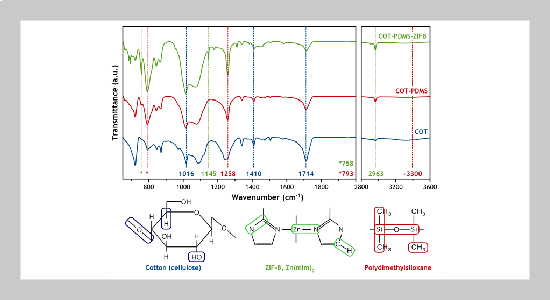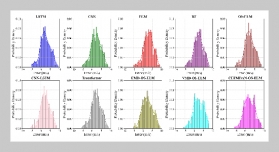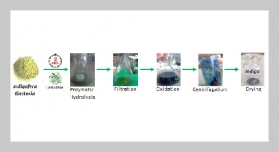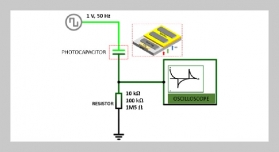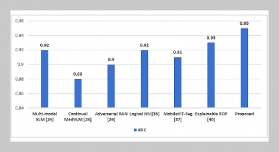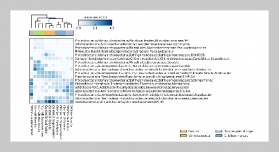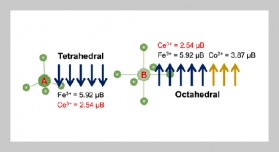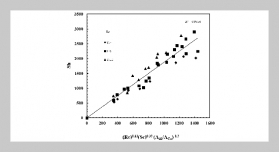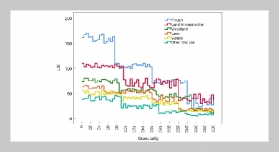- [1] G. Yue, Y. Wang, D. Li, L. Hou, Z. Cui, Q. Li, N. Wang, and Y. Zhao, (2020) “Bioinspired surface with special wettability for liquid transportation and separation" Sus�tainable Materials and Technologies 25: e00175. DOI: 10.1016/j.susmat.2020.e00175.
- [2] Z. Xu, Y. Zhao, H. Wang, X. Wang, and T. Lin, (2015) “A Superamphiphobic Coating with an Ammonia�Triggered Transition to Superhydrophilic and Superoleo�phobic for Oil–Water Separation" Angewandte Chemie International Edition 54(15): 4527–4530. DOI: 10.1002/anie.201411283.
- [3] E. Pakdel, J. Wang, R. Varley, and X. Wang, (2021) “Re�cycled carbon fiber nonwoven functionalized with fluorine�free superhydrophobic PDMS/ZIF-8 coating for efficient oil-water separation" Journal of Environmental Chem�ical Engineering 9(6): 106329. DOI: 10.1016/j.jece.2021.106329.
- [4] M. Cao, Y. Feng, Q. Chen, P. Zhang, S. Guo, and J. Yao, (2020) “Flexible Co-ZIF-L@melamine sponge with underwater superoleophobicity for water/oil separation" Materials Chemistry and Physics 241: 122385. DOI: 10.1016/j.matchemphys.2019.122385.
- [5] L. Zhang, J. Xie, X. Luo, X. Gong, and M. Zhu, (2023) “Enhanced hydrophobicity of shell-ligand-exchanged ZIF�8/melamine foam for excellent oil-water separation" Chemical Engineering Science 273: 118663. DOI: 10.1016/j.ces.2023.118663.
- [6] E. Pakdel, J. Wang, S. Kashi, L. Sun, and X. Wang, (2020) “Advances in photocatalytic self-cleaning, super�hydrophobic and electromagnetic interference shielding textile treatments" Advances in Colloid and Interface Science 277: 102116. DOI: 10.1016/j.cis.2020.102116.
- [7] X. Liao, H. Li, L. Zhang, X. Su, X. Lai, and X. Zeng, (2018) “Superhydrophobic mGO/PDMS hybrid coating on polyester fabric for oil/water separation" Progress in Organic Coatings 115: 172–180. DOI: 10.1016/j.porgcoat.2017.12.001.
- [8] A. K. Singh and J. K. Singh, (2017) “Fabrication of durable super-repellent surfaces on cotton fabric with liq�uids of varying surface tension: Low surface energy and high roughness" Applied Surface Science 416: 639– 648. DOI: 10.1016/j.apsusc.2017.04.148.
- [9] X. Yan, X. Zhu, Y. Ruan, T. Xing, G. Chen, and C. Zhou, (2020) “Biomimetic, dopamine-modified superhy�drophobic cotton fabric for oil–water separation" Cellu�lose 27(13): 7873–7885. DOI: 10.1007/s10570-020-03336-x.
- [10] Q.-Y. Cheng, C.-S. Guan, M. Wang, Y.-D. Li, and J.-B. Zeng, (2018) “Cellulose nanocrystal coated cotton fab�ric with superhydrophobicity for efficient oil/water sepa�ration" Carbohydrate Polymers 199: 390–396. DOI: 10.1016/j.carbpol.2018.07.046.
- [11] Q.-Y. Cheng, X.-P. An, Y.-D. Li, C.-L. Huang, and J.-B. Zeng, (2017) “Sustainable and Biodegradable Su�perhydrophobic Coating from Epoxidized Soybean Oil and ZnO Nanoparticles on Cellulosic Substrates for Effi�cient Oil/Water Separation" ACS Sustainable Chem�istry Engineering 5(12): 11440–11450. DOI: 10.1021/acssuschemeng.7b02549.
- [12] D. Sriramulu, E. L. Reed, M. Annamalai, T. V. Venkatesan, and S. Valiyaveettil, (2016) “Synthesis and Characterization of Superhydrophobic, Self-cleaning NIR-reflective Silica Nanoparticles" Scientific Reports 6(1): 35993. DOI: 10.1038/srep35993.
- [13] M. R. Abdul Hamid, T. C. Shean Yaw, M. Z. Mohd Tohir, W. A. Wan Abdul Karim Ghani, P. D. Sutrisna, and H.-K. Jeong, (2021) “Zeolitic imidazolate framework membranes for gas separations: Current state-of-the-art, challenges, and opportunities" Journal of Industrial and Engineering Chemistry 98: 17–41. DOI: 10.1016/j.jiec.2021.03.047.
- [14] E. E. Sann, Y. Pan, Z. Gao, S. Zhan, and F. Xia, (2018) “Highly hydrophobic ZIF-8 particles and application for oil�water separation" Separation and Purification Tech�nology 206: 186–191. DOI: 10.1016/j.seppur.2018.04.027.
- [15] H. Nabipour, X. Wang, L. Song, and Y. Hu, (2020) “Metal-organic frameworks for flame retardant polymers application: A critical review" Composites Part A: Ap�plied Science and Manufacturing 139: 106113. DOI: 10.1016/j.compositesa.2020.106113.
- [16] Y. Yang, Z. Guo, W. Huang, S. Zhang, J. Huang, H. Yang, Y. Zhou, W. Xu, and S. Gu, (2020) “Fabrica�tion of multifunctional textiles with durable antibacte�rial property and efficient oil-water separation via in situ growth of zeolitic imidazolate framework-8 (ZIF-8) on cot�ton fabric" Applied Surface Science 503: 144079. DOI: 10.1016/j.apsusc.2019.144079.
- [17] X. Yang, S. Li, Y. Yao, J. Zhao, Z. Zhu, and C. Chai, (2021) “Preparation and characterization of polypropy�lene non-woven fabric/ZIF-8 composite film for efficient oil/water separation" Polymer Testing 100: 107263. DOI: 10.1016/j.polymertesting.2021.107263.
- [18] J. Mao, M. Ge, J. Huang, Y. Lai, C. Lin, K. Zhang, K. Meng, and Y. Tang, (2017) “Constructing multifunc�tional MOF@rGO hydro-/aerogels by the self-assembly process for customized water remediation" Journal of Materials Chemistry A 5(23): 11873–11881. DOI: 10.1039/C7TA01343D.
- [19] M. Shahmirzaee, A. Hemmati-Sarapardeh, M. M. Hu�sein, M. Schaffie, and M. Ranjbar, (2020) “Develop�ment of a powerful zeolitic imidazolate framework (ZIF�8)/carbon fiber nanocomposite for separation of hydrocar�bons and crude oil from wastewater" Microporous and Mesoporous Materials 307: 110463. DOI: 10.1016/j.micromeso.2020.110463.
- [20] Y. Li, Z. Lin, X. Wang, Z. Duan, P. Lu, S. Li, D. Ji, Z. Wang, G. Li, D. Yu, and W. Liu, (2021) “High�hydrophobic ZIF-8@PLA composite aerogel and applica�tion for oil-water separation" Separation and Purifica�tion Technology 270: 118794. DOI: 10.1016/j.seppur.2021.118794.
- [21] S. R. Venna, J. B. Jasinski, and M. A. Carreon, (2010) “Structural Evolution of Zeolitic Imidazolate Framework-8" Journal of the American Chemical So�ciety 132(51): 18030–18033. DOI: 10.1021/ja109268m.
- [22] M. R. Abdul Hamid, S. Park, J. S. Kim, Y. M. Lee, and H.-K. Jeong, (2019) “Synthesis of Ultrathin Zeolitic Imidazolate Framework ZIF-8 Membranes on Polymer Hollow Fibers Using a Polymer Modification Strategy for Propylene/Propane Separation" Industrial Engineer�ing Chemistry Research 58(32): 14947–14953. DOI: 10.1021/acs.iecr.9b02969.
- [23] S. Wang, X. Sui, Y. Li, J. Li, H. Xu, Y. Zhong, L. Zhang, and Z. Mao, (2016) “Durable flame retardant finishing of cotton fabrics with organosilicon functionalized cyclot�riphosphazene" Polymer Degradation and Stability 128: 22–28. DOI: 10.1016/j.polymdegradstab.2016.02.009.
- [24] G. Malucelli, (2020) “Flame-Retardant Systems Based on Chitosan and Its Derivatives: State of the Art and Perspectives" Molecules 25(18): 4046. DOI: 10.3390/molecules25184046.
- [25] M. Maqsood and G. Seide, (2020) “Biodegradable Flame Retardants for Biodegradable Polymer" Biomolecules 10(7): 1038. DOI: 10.3390/molecules25184046.
- [26] D. Saliba, M. Ammar, M. Rammal, M. Al-Ghoul, and M. Hmadeh, (2018) “Crystal Growth of ZIF-8, ZIF�67, and Their Mixed-Metal Derivatives" Journal of the American Chemical Society 140(5): 1812–1823. DOI: 10.1021/jacs.7b11589.
- [27] Y. Pan, Y. Liu, G. Zeng, L. Zhao, and Z. Lai, (2011) “Rapid synthesis of zeolitic imidazolate framework-8 (ZIF-8) nanocrystals in an aqueous system" Chemical Communications 47(7): 2071–2073. DOI: 10.1039/C0CC05002D.
- [28] A. D. French, (2014) “Idealized powder diffraction pat�terns for cellulose polymorphs" Cellulose 21(2): 885–896. DOI: 10.1007/s10570-013-0030-4.
- [29] T. Gou, X. Wu, Q. Zhao, S. Chang, and P. Wang, (2021) “Novel phosphorus/nitrogen-rich oligomer with numerous reactive groups for durable flame-retardant cotton fabric" Cellulose 28(11): 7405–7419. DOI: 10.1007/s10570-021-03980-x.
- [30] M. Bergaoui, M. Khalfaoui, A. Awadallah-F, and S. Al-Muhtaseb, (2021) “A review of the features and ap�plications of ZIF-8 and its derivatives for separating CO2 and isomers of C3- and C4- hydrocarbons" Journal of Natural Gas Science and Engineering 96: 104289. DOI: 10.1016/j.jngse.2021.104289.
- [31] M. R. Abdul Hamid and H.-K. Jeong, (2020) “Flow synthesis of polycrystalline ZIF-8 membranes on polyvinylidene fluoride hollow fibers for recovery of hydro�gen and propylene" Journal of Industrial and Engi�neering Chemistry 88: 319–327. DOI: 10.1016/j.jiec.2020.04.031.
- [32] F. Fang, X. Zhang, Y. Meng, Z. Gu, C. Bao, X. Ding, S. Li, X. Chen, and X. Tian, (2015) “Intumescent flame retardant coatings on cotton fabric of chitosan and ammo�nium polyphosphate via layer-by-layer assembly" Surface and Coatings Technology 262: 9–14. DOI: 10.1016/j.surfcoat.2014.11.011.
- [33] J. Yu, Z. Pang, C. Zheng, T. Zhou, J. Zhang, H. Zhou, and Q. Wei, (2019) “Cotton fabric finished by PANI/TiO2 with multifunctions of conductivity, anti-ultraviolet and photocatalysis activity" Applied Surface Science 470: 84–90. DOI: 10.1016/j.apsusc.2018.11.112.
- [34] Z. Gao, N. Li, M. Chen, and W. Yi, (2019) “Compar�ative study on the pyrolysis of cellulose and its model compounds" Fuel Processing Technology 193: 131–140. DOI: 10.1016/j.fuproc.2019.04.038.
- [35] L. Xu, Y. Liu, X. Yuan, J. Wan, L. Wang, H. Pan, and Y. Shen, (2020) “One-pot preparation of robust, ultraviolet�proof superhydrophobic cotton fabrics for self-cleaning and oil/water separation" Cellulose 27(15): 9005–9026. DOI: 10.1007/s10570-020-03369-2.
- [36] J. Ran, H. Chen, S. Bi, Q. Guo, C. Yan, X. Tang, D. Cheng, G. Cai, and X. Wang, (2021) “Polydopamine�induced in-situ growth of zeolitic imidazolate framework�8/TiO2 nanoparticles on cotton fabrics for photocat�alytic performance" Progress in Organic Coatings 152: 106123. DOI: 10.1016/j.porgcoat.2020.106123.
- [37] B. Wu, B. Zhang, J. Wu, Z. Wang, H. Ma, M. Yu, L. Li, and J. Li, (2015) “Electrical Switchability and Dry-Wash Durability of Conductive Textiles" Scientific Reports 5(1): 11255. DOI: 10.1038/srep11255.
- [38] H. Bian, J. Yong, Q. Yang, X. Hou, and F. Chen, (2020) “Simple and Low-Cost Oil/Water Separation Based on the Underwater Superoleophobicity of the Existing Materials in Our Life or Nature" Frontiers in Chemistry 8: DOI: 10.3389/fchem.2020.00507.
- [39] H. Nabipour, X. Wang, L. Song, and Y. Hu, (2020) “Hydrophobic and flame-retardant finishing of cotton fab�rics for water–oil separation" Cellulose 27(7): 4145– 4159. DOI: 10.1007/s10570-020-03057-1.
- [40] G. Liu, W. Wang, and D. Yu, (2019) “Robust and self�healing superhydrophobic cotton fabric via UV induced click chemistry for oil/water separation" Cellulose 26(5): 3529–3541. DOI: 10.1007/s10570-019-02289-0.
- [41] B. P. R. O. O. N. Christina W. Kartikowati, (2020) “Manufacture of a Hydrophobic Silica Nanoparticle Com�posite Membrane for Oil-Water Emulsion Separation" International Journal of Technology 11(2): 291–319. DOI: 10.14716/ijtech.v11i2.3279.
- [42] A. Singh, M. Singh, A. Pandey, A. V. Ullas, and S. Mishra, (2023) “Hydrophobicity of cotton fabric treated with plant extract, TiO2 nanoparticles and beeswax" Ma�terials Today: Proceedings 80: 1530–1533. DOI: 10.1016/j.matpr.2023.01.353.
- [43] Electronic Article. 2020. DOI: 10.3390/coatings10100943.
- [44] Q. Zhou, B. Yan, T. Xing, and G. Chen, (2019) “Fabri�cation of superhydrophobic caffeic acid/Fe@cotton fabric and its oil-water separation performance" Carbohydrate Polymers 203: 1–9. DOI: 10.1016/j.carbpol.2018.09.025.
- [45] J. Wang and G. Geng, (2016) “Simple and eco-friendly fabrication of superhydrophobic textile for oil/water separa�tion" Environmental Technology 37(13): 1591–1596. DOI: 10.1080/09593330.2015.1122094.
- [46] D. Lin, X. Zeng, H. Li, X. Lai, and T. Wu, (2019) “One�pot fabrication of superhydrophobic and flame-retardant coatings on cotton fabrics via sol-gel reaction" Journal of Colloid and Interface Science 533: 198–206. DOI: 10.1016/j.jcis.2018.08.060.
- [47] M. Zhang, X. Shi, X. Dai, C. Huo, J. Xie, X. Li, and X. Wang, (2018) “Improving the crystallization and fire re�sistance of poly(lactic acid) with nano-ZIF-8@GO" Jour�nal of Materials Science 53(9): 7083–7093. DOI: 10.1007/s10853-018-2049-2.
- [48] Electronic Article. 2020. DOI: 10.3390/polym12081826.
- [49] N. Li, Y. Xia, Z. Mao, L. Wang, Y. Guan, and A. Zheng, (2013) “Synergistic Effect of SiO2 on Intumes�cent Flame-retardant Polypropylene" Polymers and Polymer Composites 21(7): 439–448. DOI: 10.1177/096739111302100705.
- [50] T. Chen, J. Hong, C. Peng, G. Chen, C. Yuan, Y. Xu, B. Zeng, and L. Dai, (2019) “Superhydrophobic and flame retardant cotton modified with DOPO and fluorine�silicon-containing crosslinked polymer" Carbohydrate Polymers 208: 14–21. DOI: 10.1016/j.carbpol.2018.12.023.
- [51] Y. Zheng, Y. Lu, and K. Zhou, (2019) “A novel explo�ration of metal–organic frameworks in flame-retardant epoxy composites" Journal of Thermal Analysis and Calorimetry 138(2): 905–914. DOI: 10.1007/s10973-019-08267-9.
- [52] W. Meng, H. Wu, X. Bi, Z. Huo, J. Wu, Y. Jiao, J. Xu, M. Wang, and H. Qu, (2021) “Synthesis of ZIF-8 with en�capsulated hexachlorocyclotriphosphazene and its quench�ing mechanism for flame-retardant epoxy resin" Microp�orous and Mesoporous Materials 314: 110885. DOI: 10.1016/j.micromeso.2021.110885.
- [53] F. Carosio, A. Di Pierro, J. Alongi, A. Fina, and G. Saracco, (2018) “Controlling the melt dripping of polyester fabrics by tuning the ionic strength of polyhedral oligomeric silsesquioxane and sodium montmorillonite coatings assembled through Layer by Layer" Journal of Colloid and Interface Science 510: 142–151. DOI: 10.1016/j.jcis.2017.09.059.
- [54] O. Y. Wen, M. Z. M. Tohir, T. C. S. Yeaw, M. A. Razak, H. S. Zainuddin, and M. R. A. Hamid, (2023) “Fire�resistant and flame-retardant surface finishing of polymers and textiles: A state-of-the-art review" Progress in Or�ganic Coatings 175: 107330. DOI: 10.1016/j.porgcoat.2022.107330.


